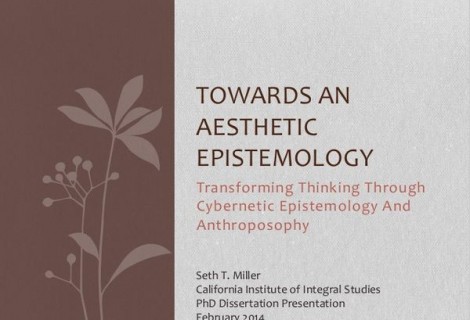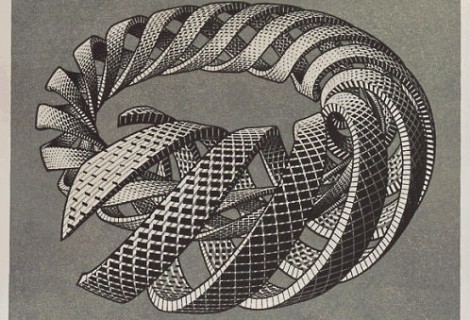Patterns in Process: Transdisciplinarity as a Background for Working with the Elemental Cycle of Transformation
« Previous Page | 1 2 3 4 5 6 7 | View All | Next Page »
Transdisciplinarity attempts to address this reification and lack of self-reflectivity by explicitly including the inquirer into the inquiry (Montuori, In Press). Alfonso Montuori, a creativity researcher and professor at the California Institute of Integral Studies, points out that this involves not simply inserting the subject into the topic, but rather evolves through recursive relationship between the subject and the topic: “in order to understand the world we must understand ourselves, and in order to understand ourselves we must understand the world” (Montuori, In Press). By purposefully and critically inserting the inquirer back into the inquiry, we are continually called to recognize that real human beings, with all our thick complexity, are the source of inquiry, and that inquiry purged of its living source tends to become both abstract and overly-reified, ossifying both itself and the discipline which supplies its formalism. As Nicolescu (2008) indicates, “knowledge is neither exterior or interior: it is simultaneously exterior and interior” (Nicolescu, 2008, p. 9, original italics)
Critically placing the self-reflexive inquirer into the inquiry process thus means that transdisciplinarity attempts to bring to light fundamental assumptions about how knowledge is constructed around the inquiry topic. In this sense, a transdisciplinary approach includes an examination not just of one’s own assumptions about the inquiry, but also the assumptions made by the dominant disciplines in which the topic is addressed, in an effort to allow theinquiry topic itself to lead the way, rather than the self-segmented and reified modes of knowledge construction adopted (or forced) by each individual discipline.
Dominant Disciplinary Discourses
Of course, in order to examine these assumptions, the dominant disciplinary discourse (DDD) must be identified, along with its major players. In the case of my own topic of inquiry, there is very little written work that deals with the Elemental Cycle, let alone how the it works in a specific way with regards to transformation. The topic itself has, obviously, deep roots in the alchemical tradition, where multiple approaches and understandings of the elements are manifest, stretching all the way back to Aristotle, Empedocles, and beyond (at the very least, the topic has some real history!), but most of this discourse is either historical in nature, esoteric, or simply dated. On top of this, the vast bulk of the alchemical works do not deal directly with the Elemental Cycle in the way that I am interested in developing it: as a formative pattern that describes a lawful process of transformation. This kind of understanding, as far as I can trace it, finds its modern roots in the work of Rudolf Steiner, whose detailed cosmology and description of human and spiritual worlds implicitly describes the relationship of the four elements as a basis for transformative processes. However, this aspect of his work was by no means central; the stages of the four elements serve less as a directly addressed content than as an oft-used structural container for his insights.
Nevertheless, some modern works on alchemy do provide a picture of the kind of style of thinking that makes the Elemental Cycle intelligible. Specifically, this is a way of thinking that meshes very well with a transdisciplinary approach, in that it embodies the “three postulates” of transdisciplinarity, as formulated by Nicolescu (2008):
- There are, in Nature and in our knowledge of Nature, different levels of Reality and, correspondingly, different levels of perception.
- The passage from one level of Reality to another is insured by the logic of the included middle.
- The structure of the totality of the levels of Reality or perception is a complex structure: every level is what it is because all the levels exist at the same time. (Nicolescu, 2008, p. 10)
That alchemy includes these postulates in its experimental and epistemological foundation is a topic for another day; the important thing to consider is that these assumptions are present in the main tradition in which my inquiry has a home.
More recently, I have been inspired by the work of Dennis Klocek, who initially introduced me to the transformative capacity of the Elemental Cycle in a seven-month long course called “Goethean Studies”. His books Seeking Spirit Vision, and The Seer’s Handbook (Klocek, 1998, 2005) do contain discussion about the elements, but the Elemental Cycle itself isn’t a major component. Nevertheless, Klocek is one of, if not the, major authority on the Elemental Cycle, and has been working with it for over 30 years. Also of note is Jochen Bockemühl, a biologist and student of Rudolf Steiner’s Spiritual Science, who considers the elements as modes of observation, that is to say, as modes of human consciousness (Bockemühl, 1985). This is directly in line with my approach to the topic, although he doesn’t explicitly generalize the theory or work with the elements as a cycle. The last major resource that deals with the elements in an analogous way is Nigel Hoffman (2007), who similarly connects the elements to ways of thinking: “The Elements are a way of understanding and entering into the different ‘dispositions of thinking’ which belong to Goethe’s way of science.” (Hoffmann, 2007, p. 22) In his book, Goethe’s Science of Living Form, Hoffman applies the different modes of thinking in a Goethean-style consideration of the Yabby Ponds area north of Sydney, Australia. However, like almost all others who have dealt with the four elements (except Klocek), Hoffman doesn’t explicitly deal with their cyclical nature, and doesn’t explicitly generalize with respect to how the elements work in regards to understanding transformation.




